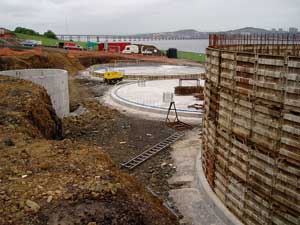
John James Henderson is a name more associated with Tayport than Newport but he could have been the person to put Newport in the forefront of environmental guardians.
In 1887 the newly created Police Commissioners of Newport (the first Town Council) had to solve the problem of the burgh’s drainage. The growth of the village had been haphazard and each property had its own sewage and drainage arrangements. A solution was desperately needed to deal with this unhealthy situation. The Commissioners decided to hold a competition and called for plans for a comprehensive drainage scheme to be submitted anonymously, the best two schemes as decided by an independent adjudicator being awarded prizes of £20 and £10.
The winning scheme, which with some amendments was put into practice, created 4 sewer outfalls directly into the River Tay at Riverside Lane, the old harbour, James Street and Bank Street. All the raw sewage from the burgh would be fed into these pipes, sent into the river and the Commissioners could wash their hands of it.
J J Henderson was well-qualified in drainage schemes. He was a civil engineer and architect with previous experience of municipal engineering and sanitation arrangements. And he was a man ahead of his time. He had submitted an entry in the Newport competition but it was judged too expensive, coming in just under double the cost of the £2600 winner.
Disappointed at not winning, and seeking to explain both the reasons for the cost of his scheme and the benefits it would give to the people of Newport, he wrote a letter to the Editor of the Courier in January 1888.
His scheme would “take all the sewage of the burgh by an intercepting sewer, carried along nearly the whole length of the foreshore, near high water mark, to a gathering tank at Craighead Point, and there, by one outlet, discharge it into the river during the central three and a half hours of the ebb tide by an automatic arrangement of valves”.
Does it sound familiar?
Well, this was the very scheme adopted by Scottish Water in 2006, except that the intercepting sewer now runs along the main road and is dependent on electricity to pump it to the treatment works between Newport and Tayport.

Henderson also foresaw the sewage treatment works, as he noted in his explanation : “Sanitary science … has advanced by such rapid strides within recent years that it would be difficult to set a limit to its progress during the immediate future in the direction of purification of sewage. Such being the case I have kept in view the possibility of the [Commissioners] being called upon, within a reasonable period, to undertake the disposal of the sewage of the burgh otherwise than by casting it, in all its native filthiness, into the river”.
But money talks.
And so, as Henderson went on to say, the “enjoyable use [of the foreshore] by the inhabitants, either in boating, bathing or walking, may be increased by the absence of sewage matter” was an expectation that would not be realised for 118 years.
Sources:
- Obituary, Dundee Courier, 8 April 1902, p.4; Image © THE BRITISH LIBRARY BOARD. ALL RIGHTS RESERVED.
- Letters to the Editor, Dundee Courier, 14 January 1888, p.2
- Newport Burgh Commissioners business as reported in the local press 1887-88.
- Tayport wastewater treatment works: http://www.georgeleslie.co.uk/what-we-do/case-study/tayport-wastewater-treatment-works/ – link now dead
